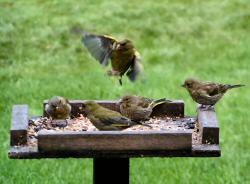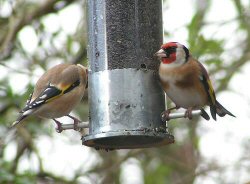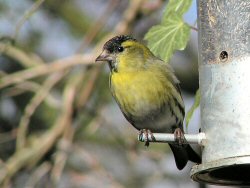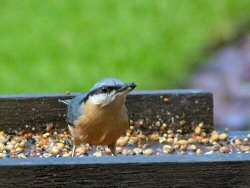Features: Wildlife Trust Articles |  |
Feeding the birds Greenfiches (Carduelis chloris) on a traditional bird table.
When I first 'seriously' started feeding garden birds as a boy in the 1970's, I was fairly unusual: none of my friends or neighbours did so (apart from putting out odd kitchen scraps). Greenfiches (Carduelis chloris) on a traditional bird table.
When I first 'seriously' started feeding garden birds as a boy in the 1970's, I was fairly unusual: none of my friends or neighbours did so (apart from putting out odd kitchen scraps).  Compared to today's standards, the food you could buy for wild birds was rudimentary Compared to today's standards, the food you could buy for wild birds was rudimentary Compared to today's standards, the food you could buy for wild birds was rudimentary: staples included unshelled peanuts (monkey nuts) threaded on a string and half a coconut suspended for tits. Unsalted peanuts and 'special' mixes of seed (actually rather poor mixes) had only just started to become available from pet shops. Virtually the only specialised bird feeding devices available were simple wire mesh containers which could be used with peanuts or sunflower seeds. Compared to today's standards, the food you could buy for wild birds was rudimentary: staples included unshelled peanuts (monkey nuts) threaded on a string and half a coconut suspended for tits. Unsalted peanuts and 'special' mixes of seed (actually rather poor mixes) had only just started to become available from pet shops. Virtually the only specialised bird feeding devices available were simple wire mesh containers which could be used with peanuts or sunflower seeds.
A growth industry
We've come a long way.  Nowadays you would be hard pressed to find even a small suburban street where there is not at least one householder making a special effort to feed garden birds Nowadays you would be hard pressed to find even a small suburban street where there is not at least one householder making a special effort to feed garden birds Nowadays you would be hard pressed to find even a small suburban street where there is not at least one householder making a special effort to feed garden birds. Most streets will boast many more. Chris Whittles (chairman of CJ WildBird Foods and a pioneer of the bird feeding industry) estimates the market to be worth £180 million a year; and he thinks that this could grow to something in the region of £500 million within 10 years! That's a lot of people feeding a lot of birds. Nowadays you would be hard pressed to find even a small suburban street where there is not at least one householder making a special effort to feed garden birds. Most streets will boast many more. Chris Whittles (chairman of CJ WildBird Foods and a pioneer of the bird feeding industry) estimates the market to be worth £180 million a year; and he thinks that this could grow to something in the region of £500 million within 10 years! That's a lot of people feeding a lot of birds.
The array of bird food and feeding devices available now is astounding.  The greatest improvement has been where it matters most: the quality of the food The greatest improvement has been where it matters most: the quality of the food The greatest improvement has been where it matters most: the quality of the food. Gone are the days when you would have to settle for about 50% corn or maize in your wild bird seed mixes. The greatest improvement has been where it matters most: the quality of the food. Gone are the days when you would have to settle for about 50% corn or maize in your wild bird seed mixes.
 Goldfinches (Carduelis carduelis) on a nyger seed feeder: a recent addition to the bird feeder's bag of tricks.
Vendors now offer superb quality mixes where, in the average garden, every scrap will be taken by one species or another. You can also buy special 'soft-bill' mixes for birds like wrens, dunnocks, robins and thrushes which do not favour the harder seeds traditionally put out. Goldfinches (Carduelis carduelis) on a nyger seed feeder: a recent addition to the bird feeder's bag of tricks.
Vendors now offer superb quality mixes where, in the average garden, every scrap will be taken by one species or another. You can also buy special 'soft-bill' mixes for birds like wrens, dunnocks, robins and thrushes which do not favour the harder seeds traditionally put out.
The range of 'straight' or 'single' foods available has expanded to include black sunflower seeds (irresistible to many finches and tits), sunflower hearts, nyger seeds (a great favourite of goldfinches and siskins), linseed, oilseed, pinhead oats, peanut granules, raisins and more. Live foods like mealworms, waxworms and earthworms mean that you can cater for even the most steadfastly carnivorous birds!  Many of these foodstuffs can be offered up in dispensers designed to make them accessible whilst keeping the food itself dry and healthy Many of these foodstuffs can be offered up in dispensers designed to make them accessible whilst keeping the food itself dry and healthy Many of these foodstuffs can be offered up in dispensers designed to make them accessible whilst keeping the food itself dry and healthy. Some are also equipped with devices to stop the more robust birds and animals (e.g. magpies and grey squirrels) from taking all the food. Many of these foodstuffs can be offered up in dispensers designed to make them accessible whilst keeping the food itself dry and healthy. Some are also equipped with devices to stop the more robust birds and animals (e.g. magpies and grey squirrels) from taking all the food.
Add to all this the ever expanding number of outlets like major supermarkets, garden centres and, of course, the internet, and you can see why effective feeding of garden birds has become easier than ever before.
When to feed Female blackbird (Turdus merula) at a bird table. Female blackbird (Turdus merula) at a bird table.
Another big change that has occurred over the last decades is that the major bird research and welfare organisations (like the Royal Society for the Protection of Birds and the British Trust for Ornithology) now recommend that we feed throughout the year.
The advice used to be to feed during the autumn and winter only; natural foods were thought to be abundant during other seasons. But  we now suspect that natural food is not as plentiful as it once was over the spring and summer we now suspect that natural food is not as plentiful as it once was over the spring and summer we now suspect that natural food is not as plentiful as it once was over the spring and summer and we also now recognise the huge energy demands placed on both adult and young birds at this time of year: if we supply extra food, the chances of nesting success and fledgling survival can increase dramatically. we now suspect that natural food is not as plentiful as it once was over the spring and summer and we also now recognise the huge energy demands placed on both adult and young birds at this time of year: if we supply extra food, the chances of nesting success and fledgling survival can increase dramatically.
That doesn't alter the fact that winter feeding can be absolutely vital for the survival of many garden birds during hard weather and is probably still the time of year when we can do most good.
Good feeding practice
Feeding garden birds has to be done with some thought and care: done incorrectly it can actually do more harm than good.  One of the most important things to think about is hygiene. Birds are susceptible to disease brought on by sub-standard foodstuffs or poorly maintained feeding stations One of the most important things to think about is hygiene. Birds are susceptible to disease brought on by sub-standard foodstuffs or poorly maintained feeding stations One of the most important things to think about is hygiene. Birds are susceptible to disease brought on by sub-standard foodstuffs or poorly maintained feeding stations. One of the most important things to think about is hygiene. Birds are susceptible to disease brought on by sub-standard foodstuffs or poorly maintained feeding stations.
 Male siskin (Carduelis spinus) on a nyger seed feeder. Like the goldfinch, the fine bill of this species enable it to tackle the small nyger seeds.
Feeders and bird tables should be regularly cleaned with plenty of clean water and even a mild disinfectant. This helps prevent diseases like salmonellosis and avian lymphomatosis, which can also spread to people. It is recommended that you use gloves when cleaning bird feeders and, if possible, you do it out of doors - certainly away from your own food preparation areas. Always buy food from reputable suppliers: this will reduce the chances of you unwittingly introducing toxic substances like aflatoxins (which are produced by fungi found in sub-standard peanuts) into the birds diet. Male siskin (Carduelis spinus) on a nyger seed feeder. Like the goldfinch, the fine bill of this species enable it to tackle the small nyger seeds.
Feeders and bird tables should be regularly cleaned with plenty of clean water and even a mild disinfectant. This helps prevent diseases like salmonellosis and avian lymphomatosis, which can also spread to people. It is recommended that you use gloves when cleaning bird feeders and, if possible, you do it out of doors - certainly away from your own food preparation areas. Always buy food from reputable suppliers: this will reduce the chances of you unwittingly introducing toxic substances like aflatoxins (which are produced by fungi found in sub-standard peanuts) into the birds diet.
Where possible, you should regularly move feeders around the garden. If you cannot do this then pay special attention to clearing up discarded food and husks that accumulate around feeding stations. Very large groups of birds vying for the best feeding spots can be stressful to the individuals, so provide as many feeding ports as possible - preferably spread around the garden. Place feeding stations close enough to cover so that birds can feel safe and escape from predators like sparrow hawks, but far enough away from potential ambush spots for cats.
 Nuthatch (Sitta europaea): a less frequent, but very handsome visitor to bird feeding stations. Nuthatch (Sitta europaea): a less frequent, but very handsome visitor to bird feeding stations. If you are going to feed birds during the breeding season, then make sure that large foodstuffs like whole peanuts are only supplied in wire mesh feeders which will ensure that they are broken up by the adults before being fed to nestlings If you are going to feed birds during the breeding season, then make sure that large foodstuffs like whole peanuts are only supplied in wire mesh feeders which will ensure that they are broken up by the adults before being fed to nestlings If you are going to feed birds during the breeding season, then make sure that large foodstuffs like whole peanuts are only supplied in wire mesh feeders which will ensure that they are broken up by the adults before being fed to nestlings. There is a suspicion that flexible plastic mesh bags of peanuts (commonly coloured red) can entangle and trap the feet of birds, so use the inflexible wire mesh feeders in preference. If you are going to feed birds during the breeding season, then make sure that large foodstuffs like whole peanuts are only supplied in wire mesh feeders which will ensure that they are broken up by the adults before being fed to nestlings. There is a suspicion that flexible plastic mesh bags of peanuts (commonly coloured red) can entangle and trap the feet of birds, so use the inflexible wire mesh feeders in preference.
Finally  remember that water is just as important to birds as food, particularly in winter when birds need to bathe regularly in order to keep their feathers in the best condition for withstanding the winter cold remember that water is just as important to birds as food, particularly in winter when birds need to bathe regularly in order to keep their feathers in the best condition for withstanding the winter cold remember that water is just as important to birds as food, particularly in winter when birds need to bathe regularly in order to keep their feathers in the best condition for withstanding the winter cold. So please make sure that you supply regularly topped up clean bathing and drinking water to complement your feeding. remember that water is just as important to birds as food, particularly in winter when birds need to bathe regularly in order to keep their feathers in the best condition for withstanding the winter cold. So please make sure that you supply regularly topped up clean bathing and drinking water to complement your feeding.
As long as these basic guidelines are followed we can be sure that the birds will benefit from our feeding; repaying our efforts with stunning views of arguably the most spectacular wildlife to visit our gardens.
| First published November 2004. | |
Copyright Richard Burkmar. Permission is hereby granted for anyone to use this article for non-commercial purposes which are of benefit to the natural environment as long the original author is credited. School pupils, students, teachers and educators are invited to use the article freely. Use for commercial purposes is prohibited unless permission is obtained from the copyright holder. |
Back to home page
Do you live in Merseyside? Interested in its wildlife? |